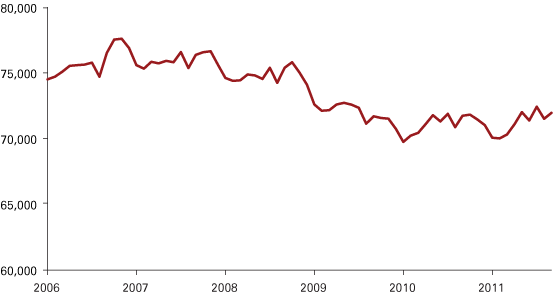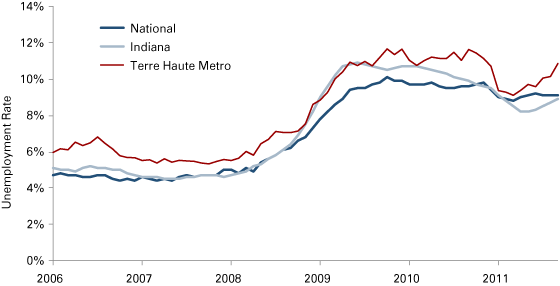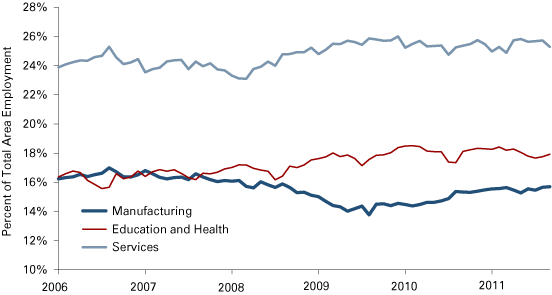Terre Haute Forecast 2012
Associate Professor of Economics, Rose-Hulman Institute of Technology
Professor of Economics, Indiana State University
The outlook for the Terre Haute regional economy is much like the campaign slogan of Terre Haute’s newly re-elected mayor Duke Bennett: “Responsible Progress.” The city has managed to navigate the drain on revenues resulting from property tax caps while simultaneously developing a plan to deal with its combined sewer overflow problems in an EPA-compliant fashion. While employment figures make it abundantly clear that many of the area’s residents continue to struggle to find work, the city is living within its means.
The bright spots are mostly confined to the relatively healthy education and health sectors. Rose-Hulman Institute of Technology, Indiana State University and the Wabash Valley campus of Ivy Tech Community College are all experiencing robust enrollment and working on significant building projects. The expansion of Union Hospital is complete and both it and Regional HCA continue to provide stable employment for many. Those looking for other hopeful signs might point to a continued healthy relationship between the city and its largest private employers (Sony, Bemis and Alorica) that could well be enhanced by the stability associated with having the first re-elected mayor in 20 years.
The downtown area continues to revive, with new facilities under construction for a local TV station and radio station, the latter of which will include new office and retail space. Additionally, the renovation of a former federal building is well underway. In June 2012, it will become the new home of Indiana State’s Scott College of Business. The relocation of the college to the northern edge of downtown will continue a revitalization of the area that has been ongoing since 2007.
Labor Market
Despite these successes, one cannot ignore the conclusion that the Terre Haute regional economy is stuck in the same stagnant environment that affects the state of Indiana and the nation. Almost 30 months into an official recovery from the worst recession since the 1930s, the Terre Haute economy continues to be sluggish and offers few signs of any imminent return to robust growth. Since peaking in November 2006, area employment has sputtered downward, with about 5,600 fewer people employed in the area today (see Figure 1).
Figure 1: Terre Haute Regional Employment, January 2006 to September 2011

Source: U.S. Bureau of Labor Statistics (not seasonally adjusted data)
After improving rather dramatically between the fall of 2010 and the spring of 2011, the Terre Haute labor market weakened considerably during the last half of 2011. On a seasonally adjusted basis, the local unemployment rate fell to 9.1 percent by March 2011, but has since climbed to 10.8 percent. In this respect, the Terre Haute labor market mirrors the performance of the state labor market and is showing slightly more weakness than the national labor market (see Figure 2).
Figure 2: Seasonally Adjusted Unemployment Rates, January 2006 to September 2011

Source: U.S. Bureau of Labor Statistics, STATS Indiana and authors’ calculations
The manufacturing sector, once the bulwark of the regional economy, continues to be buffeted by sluggish macroeconomic trends and to decline in relative importance to the area economy. Although as a percent of total area employment, the manufacturing sector’s decline since 2006 looks slight (and has actually recovered a bit since a low point in the summer of 2009), it must be remembered that such percentages occur against a backdrop of an overall contraction of the local labor market. Since the peak month of November 2006, the area’s manufacturing sector has shed 1,400 jobs. The only sectors to record a net gain in jobs during that period were the education and health sectors, which employ 200 more people today than in November 2006.
Figure 3: Sectoral Composition of Employment for Terre Haute Regional Economy, January 2006 to September 2011

Source: U.S. Bureau of Labor Statistics
Outlook
After recording employment growth that was largely identical to state growth during the previous decade, the prospects for near-term employment growth look weak. The Indiana University Center for Econometric Model Research estimates that Terre Haute’s employment growth rates are likely to be lower than the state’s in the near future.
Though the education and health sectors have been relatively healthy, there are no plans to increase employment at Indiana State or Rose-Hulman in the near future. Though the federal penitentiary facilities have expanded, it is not likely that additional facilities will be constructed in the city. The hope that existed for the GE Aviation F136 alternative engine project was largely dashed on the rocks of federal budget issues.
Neither the Center nor we believe it likely that the Terre Haute economy will spontaneously or independently expand. Local businesses and education and health institutions are holding their own against the landscape of a weak national economy, but a dramatic change in the trajectory of the area economy will require injection of new investment from outside the area. In short, despite consistent and laudable efforts by the Terre Haute Economic Development Corporation, the results for the city and the area remain modest.
Also in this Issue…
- Outlook for 2012
- International Outlook for 2012
- U.S. Outlook for 2012
- Financial Outlook for 2012
- Housing Market Outlook for 2012
- Indiana's Outlook for 2012
- Indiana's Agricultural Outlook for 2012
- Anderson Forecast 2012
- Bloomington Forecast 2012
- Columbus Forecast 2012
- Evansville Forecast 2012
- Fort Wayne Forecast 2012
- Gary Forecast 2012
- Indianapolis-Carmel Forecast 2012
- Kokomo Forecast 2012
- Lafayette Forecast 2012
- Louisville Forecast 2012
- Muncie Forecast 2012
- Richmond Forecast 2012
- South Bend and Elkhart Area Forecast 2012
- Terre Haute Forecast 2012




